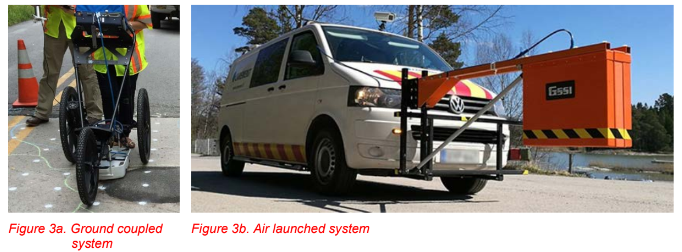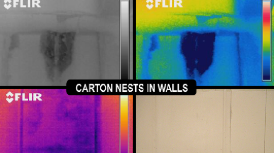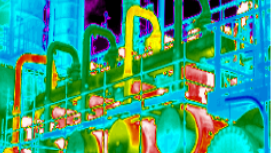Using Infrared Thermography and an Air Launched GPR System to Assess the Condition of Reinforced Concrete Structures at Posted Speeds
InfraMation 2018 Application Paper Submission
Nicole Martino
Roger Williams University
ABSTRACT
Previous research has indicated that ground coupled Ground Penetrating Radar (GPR) and Infrared Thermography (IR) have the ability to identify areas of subsurface deterioration in bare reinforced concrete bridge decks. Using these nondestructive evaluation tools to identify damage are advantageous for state agencies because they can; uncover subsurface damage before the standard method of bridge deck inspection, visual inspection; accurately locate these areas, and categorize the extent of damage (rebar corrosion and/or delaminations). The payoffs for state agencies include better prioritization and repair scheduling, and improved repair cost estimates.
The research presented in this paper extends the use of these technologies to decks with an asphalt overlay, which is typical in snow-belt states, and incorporates an air launched GPR system into the research. The idea behind integrating the air launched GPR system is that it can collect data at driving speeds, as opposed to the ground coupled system that is walked across the deck and requires lane closures. This paper looks into whether the air launched and ground coupled systems will identify the same areas of deterioration.
This paper presents the results of ground coupled GPR and IR data collected from two asphalt overlaid decks, in addition to comparing the rebar level signal attenuation maps of ground coupled and air launched GPR data collected from one bare reinforced concrete bridge deck. The surface temperature color contour plots generated from previously collected IR data is included in the analysis. Based on the very promising results displayed in this paper, these technologies can soon be brought into regularly scheduled, biyearly, bridge deck inspections.
INTRODUCTION
Using nondestructive evaluation techniques like ground penetrating radar and infrared thermography to understand subsurface conditions in reinforced concrete bridge decks is of interest to many state departments of transportation, include Rhode Island’s. These techniques have a number of advantages over conventional and mandated bridge deck inspection methods (visual inspection and chain drag) including;
- Uncovering damage, like rebar corrosion, when it is in its early stage and not visible via cracks on a surface of the deck;
- Detecting debonding between the asphalt overlay and the concrete deck; 3. Performing the assessment without closing the deck to traffic;
- Accurately detecting locations and damage type (rebar corrosion, delaminations, etc.) 5. Accurately quantifying the percentage (%) of the deck that is deteriorated.
Advantages like those listed above help state agencies better prepare for deck repairs, rehabilitation and/or replacement in terms of; scheduling, cost, prioritization, and repair type, to name a few. Up until this point, the Rhode Island Department of Transportation (RIDOT) has completed a project, where results suggest that GPR and IR can successfully be used to uncover subsurface damage in bare reinforced concrete bridge decks. Those results were disseminated at InfraMation 2016 (Martino et al. 2016). Their current research project objectives, using GPR and IR, are to understand if these technologies can be used, just as successfully, when collecting data from reinforced concrete decks with an asphalt overlay. Minimal literature exists (Maser 2009), that discusses the use of both GPR and IR for this specific application, and it does not provide any “how to” information. Additionally, this project sets out to understand if a high speed (air launched) radar system will provide the same information in comparison to the ground coupled system used in (Martino et al. 2016). Again, minimal literature (Maser et al. 2014,
Martino et al. 2015) exists to support this claim, prompting the RIDOT to investigate this using their bridge inventory.
ASPHALT OVERLAID DECKS
The paper that the author presented at InfraMation 2016 (Martino et al. 2016), discusses how GPR and IR are used to identify deterioration within the subsurface of bare reinforced concrete bridge decks, in addition to discussing the procedures implemented to collect and post process data. Instead of repeating that information, the results of two asphalt overlaid decks are directly presented below.
Qualitative Results
Overlaid Concrete Deck 1:

Overlaid Concrete Deck 2:


Observations of the qualitative color contour plots include good agreement between the GPR and IR results when comparing undamaged “green” regions and damaged “red” regions. It is important to note that GPR detects rebar corrosion which exists before, during and after delaminations/debonding (detected by IR) are present. Therefore, if deterioration is in its early stage, the GPR and IR results will differ, and just the GPR data will indicate damage.
Both of these overlaid decks have subsurface deterioration. The first overlaid deck has corroded rebar at the northern joint, but not severe enough to cause overlay debonding, as indicated by the IR data. Cores of the northern joint confirm these results. The second overlaid deck has a longitudinal crack that exists for the entire length of the deck in the north bound lane. This crack, which is most likely atop of two adjoining box girders, has allowed chloride infiltration. This has resulted in rebar corrosion and overlay debonding, indicated using the red color in both the GPR and IR contour plots, at this location.
These results were also quantitatively evaluated, by calculating an area percentage in which damage exists. This percentage was calculated for each method and is displayed in Table 1. Observations of these results indicate that a larger area of the decks are experiencing deterioration according to GPR, in comparison to IR. This is expected based on what GPR and IR detect individually. This quantitative analysis also compared the GPR and IR results of every spatial coordinate, and determined how many of those coordinates agree. The fourth column of Table 1 displays these results, indicating excellent spatial agreement. This shows that damaged and healthy locations as indicated by GPR are mostly in agreement with those suggested by IR.
GROUND COUPLED VS. AIR LAUNCHED GPR
In addition to the RIDOT owning a ground coupled GPR system, they also recently purchased an air launched system comprised of a SIR 20 and a 2GHz center frequency antenna. The ground coupled system requires a person to walk on the surface of the bridge deck while pushing the antenna which is attached to a cart (Figure 3a). The air launched system uses an antenna secured to the front or rear of a vehicle, and data is collected by driving the vehicle over the bridge deck (Figure 3b). The main advantage of using the air launched system is that traffic is not impacted because data can be collected at posted speeds, alongside other traveling vehicles. Additionally, using this system keeps inspectors completely off the deck, providing a much safer environment, and collects data at a far more rapid rate in comparison to the ground coupled system. The main disadvantage of using the air launched system is that data is not collected in as much detail, in comparison to the ground coupled system. The results below compare radar data collected using both the ground coupled system and air launched system, to understand if anomalies uncovered by the ground coupled system can also be detected by the air launched system.


Figures 4a and 4b display the variation in reflection amplitudes associated with the top rebar collected using an air launched and ground coupled GPR system, respectively. The deck presented is a newly installed bare reinforced concrete bridge deck, and therefore shouldn’t have any signs of rebar corrosion or delaminations. Indeed, there are no signs of corrosion, and this can be observed by the minimal variation in amplitude throughout the entire bird’s eye view, color contour plots. Interestingly enough, while the variation is minimal, both plots (air launched and ground coupled) vary in the same locations. This shows that the same artifacts can be identified with both systems. Figure 4c displays the surface temperatures collected from the deck with the infrared camera. While there is an area colored red, near the southern joint, this is a cooler area in comparison to the rest of the deck. This area was covered with shadows created by nearby trees, during data collection. Besides this cooler area, there is less than a 3 degree Fahrenheit difference throughout the area highlighted in green. If there were a delamination, a hot spot, or an isolated location of warmer surface temperatures would be observed. These locations do not exist in this plot, as expected with a newly installed deck.
SUMMARY
In summary, a ground coupled GPR system coupled with an IR camera can successfully be used together to uncover subsurface deterioration in overlaid reinforced concrete bridge decks. This is important, especially for the RIDOT, as about 90% of their decks are asphalt overlaid. Additionally, the later portion of the paper showed that an air launched GPR system can uncover the same anomalies as a ground coupled GPR system. Putting these outcomes together provides the RIDOT with confidence to implement regular subsurface evaluations with the air launched GPR system and IR camera.
REFERENCES
Martino, N., Sock, M., Morgan, D., and Nazareth, C. (2016). “Coupling GPR and IR Thermography to Detect Damage in Reinforced Concrete Bridge Decks,” Proceedings of InfraMation 2016, Las Vegas, NV, September 27-29, 2016.
Martino, N., Maser, K., and Birken, R., (2015). “Adapting a Ground Coupled GPR Threshold Model for use with Air Coupled GPR Systems,” Proceedings of the International Symposium on Non-Destructive Testing in Civil Engineering (NDT-CE), Berlin, Germany, September 15-17, 2015.
Maser, K., Guarino, E., and Martino, N., (2014). “Comparison of Ground-Coupled and Air-Launched Ground Penetrating Radar Methods for Bridge Deck Condition Evaluation,” Proceedings of the NDE/NDT for Structural Materials Technology for Highways and Bridges, Washington, DC, August 25-27, 2014.
Maser, K., (2009). "Integration of Ground Penetrating Radar and Infrared Thermography for Bridge Deck Condition Assessment," Proceedings of the 7th International Symposium on Non-Destructive Testing in Civil Engineering, Nantes, France, 2009.
ACKNOWLEDGEMENTS
The author would like to thank the RIDOT for funding this research.
ABOUT THE AUTHOR
Nicole Martino is an Assistant Professor of Engineering at Roger Williams University in Bristol, Rhode Island. She earned her Ph.D in 2013 from the Civil and Environmental Engineering Department, with a focus in Structural Engineering, at Northeastern University in Boston, Massachusetts. Her research expertise is assessing the level of reinforced concrete bridge deck deterioration using mechanical, electrochemical and electromagnetic techniques. She has completed numerous field, laboratory and computer modeling studies about this topic, in addition to publishing a number of papers. Her work currently focuses on creating tools, applications, and manuals for immediate and accurate bridge deck condition assessments that are user friendly to transportation agencies.


